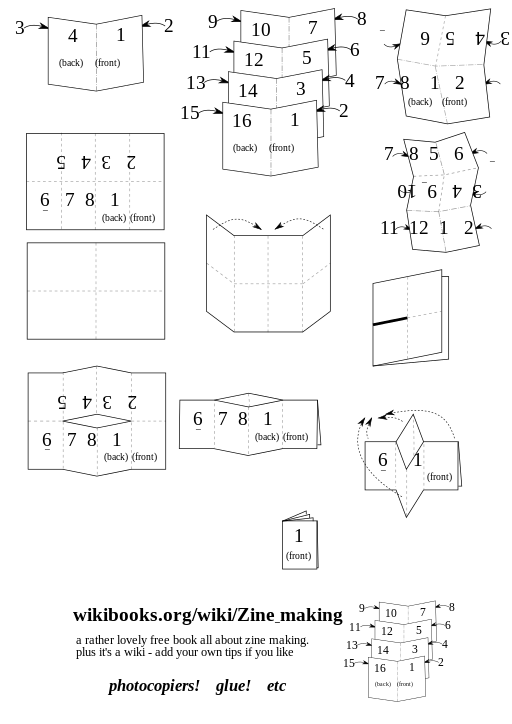Context
For this assessment task, the instructor was looking for a way to incorporate zine making to demonstrate research in a course on innovative research methodologies, ECED 565*. Zines have a long history in activist and counter-cultural spaces as a way of disseminating knowledge typically rejected by mainstream publications. Students needed to show their research through the artifact, but also find a way to justify how they expressed the research through their zine. It was decided that alongside the zine, students would also do a presentation to share their research and justification.
Demonstration
Zines can be created in a variety of different formats, with the only vital component being a piece of paper. See below this diagram showing different configurations for a zine:

This shows a variety of configurations and ways to fold one or multiple pieces of paper. A zine of 8 pages can be made easily with one sheet of paper. Additional materials such as pens, pencils, markers, glue and scissors will also be needed. A photocopier or printer is also useful if students wish to make multiple copies of their zine for distribution. Image by Mcld, CC BY-SA 3.0 <https://creativecommons.org/licenses/by-sa/3.0>, via Wikimedia Commons
Pedagogical Pros and Cons
Zine making has a variety of pedagogical benefits, offering a creative way for student voice to shine, humanizing learning and research presentation. It can also give students opportunities to share their own stories, and become more familiar with creating their own publications.
This task was designed for an in-person synchronous class where tangible zine-making materials could be provided (paper, pens, newspapers/magazines, glue, etc…). This means it would be more difficult to create and present a zine in a fully online learning environment where the materials cannot be provided. However, with zines being a do-it-yourself publication, materials needed are often minimal, inexpensive and readily sourced. Presentations of zines could be done in online learning environments in video presentation format, or scanned and then annotated as a means of showing and justifying research and design choices.
*Dr. Iris Berger adapted this assignment from sessional lecturer Nancy Van Groll.